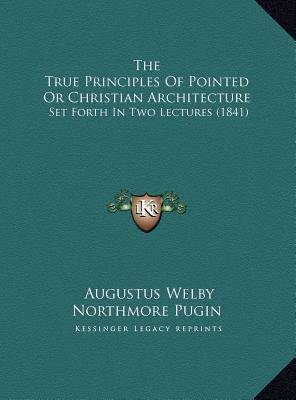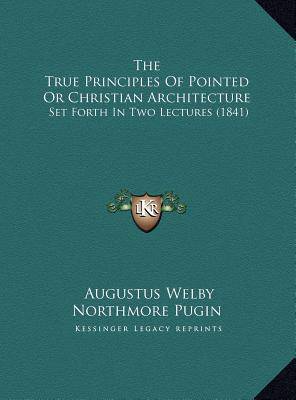
Door een staking bij bpost kan je online bestelling op dit moment iets langer onderweg zijn dan voorzien. Dringend iets nodig? Onze winkels ontvangen jou met open armen!
- Afhalen na 1 uur in een winkel met voorraad
- Gratis thuislevering in België vanaf € 30
- Ruim aanbod met 7 miljoen producten
Door een staking bij bpost kan je online bestelling op dit moment iets langer onderweg zijn dan voorzien. Dringend iets nodig? Onze winkels ontvangen jou met open armen!
- Afhalen na 1 uur in een winkel met voorraad
- Gratis thuislevering in België vanaf € 30
- Ruim aanbod met 7 miljoen producten
Zoeken
The True Principles Of Pointed Or Christian Architecture
Set Forth In Two Lectures (1841)
Augustus Welby Northmore Pugin
Hardcover | Engels
€ 52,95
+ 105 punten
Uitvoering
Omschrijving
The True Principles of Pointed or Christian Architecture: Set Forth in Two Lectures is a book written by Augustus Welby Northmore Pugin and published in 1841. Pugin was a prominent English architect and designer who played a significant role in the Gothic Revival movement of the 19th century. In this book, he argues for the superiority of Gothic architecture over other styles, particularly classical architecture, which he believed was unsuited to the needs of the Christian church. The book consists of two lectures that Pugin delivered at the University of Cambridge in 1837. In the first lecture, he discusses the history and development of Gothic architecture, tracing its roots back to the early Christian church and the Romanesque style. He argues that Gothic architecture is uniquely suited to the needs of Christian worship, as it embodies the principles of simplicity, purity, and spiritual transcendence. In the second lecture, Pugin goes into more detail about the specific elements of Gothic architecture, such as the pointed arch, the ribbed vault, and the flying buttress. He explains how these features work together to create a sense of harmony and unity in the building, and how they reflect the spiritual ideals of the Christian faith. Throughout the book, Pugin emphasizes the importance of architecture as a means of expressing religious beliefs and values. He argues that Gothic architecture is not just a matter of style or fashion, but a reflection of the deepest spiritual truths. His book was influential in shaping the Gothic Revival movement, which sought to revive the traditions of medieval architecture in the modern world. Today, The True Principles of Pointed or Christian Architecture is considered a classic work on the subject, and is still studied and admired by architects and scholars alike.This scarce antiquarian book is a facsimile reprint of the old original and may contain some imperfections such as library marks and notations. Because we believe this work is culturally important, we have made it available as part of our commitment for protecting, preserving, and promoting the world's literature in affordable, high quality, modern editions, that are true to their original work.
Specificaties
Betrokkenen
- Auteur(s):
- Uitgeverij:
Inhoud
- Aantal bladzijden:
- 148
- Taal:
- Engels
Eigenschappen
- Productcode (EAN):
- 9781169715820
- Verschijningsdatum:
- 10/09/2010
- Uitvoering:
- Hardcover
- Formaat:
- Genaaid
- Afmetingen:
- 216 mm x 279 mm
- Gewicht:
- 635 g

Alleen bij Standaard Boekhandel
+ 105 punten op je klantenkaart van Standaard Boekhandel
Beoordelingen
We publiceren alleen reviews die voldoen aan de voorwaarden voor reviews. Bekijk onze voorwaarden voor reviews.











